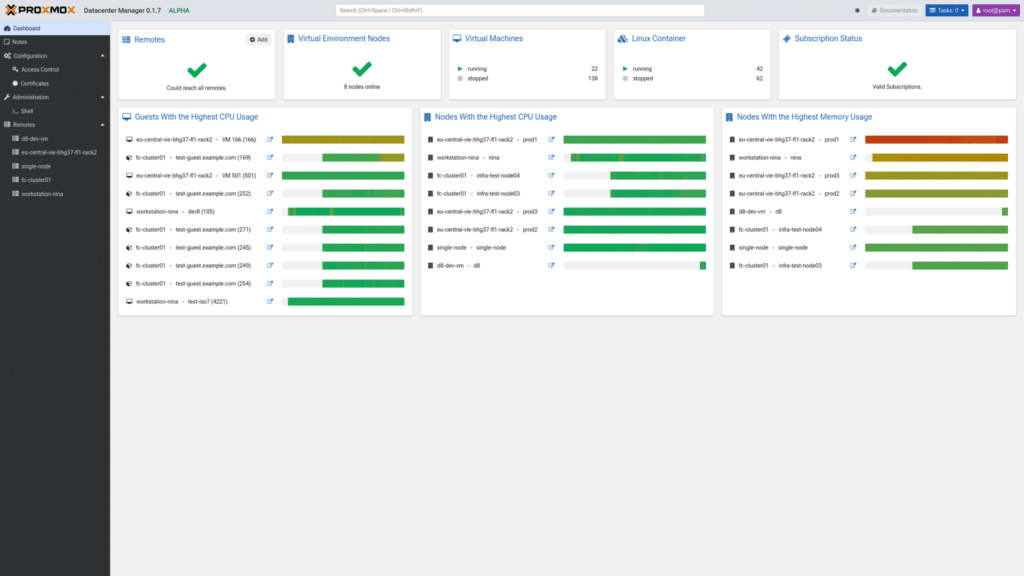Proxmox debuts Datacenter Manager Alpha, a significant step in simplifying virtualized server management.
In a move aimed at expanding its reach within the datacenter management market, Proxmox Server Solutions has unveiled the Alpha version of its open-source project, Proxmox Datacenter Manager (PDM). This initial release provides an early preview of the tool designed to streamline the management of virtualized environments and encourage community collaboration.

Simplifying Large-Scale Server Management
Proxmox Datacenter Manager introduces a centralized interface for managing Proxmox Virtual Environment (VE) nodes and clusters. While the management capabilities are currently basic, including functions such as resource monitoring, power controls, and virtual machine migration, the tool aims to simplify operations for larger-scale deployments. Future iterations promise to expand functionality, including integrating software-defined networking (SDN) capabilities.
The Alpha leverages a completely redesigned web interface developed in Rust, ensuring a modern, efficient, visually appealing user experience. This new front end is built using Proxmox’s proprietary Yew Widget Toolkit, a system optimized for speed, accessibility, and seamless platform compatibility.
Why Release Proxmox Datacenter Manager in Alpha?
This Alpha release is an interesting move by Proxmox, as it aims to engage its community early in the development process. With its primary goal being feedback collection, this release allows users and developers to influence the project’s trajectory. The Alpha also serves as a testing ground for core features, with bugs and incomplete elements expected at this stage.
The company has outlined a roadmap extending through 2025, culminating in releasing the first stable version. Key milestones include ongoing feature development, a beta release in early 2025, and eventual support for additional Proxmox projects, such as the Proxmox Backup Server.
Proxmox Datacenter Manager Features
| Main Features | Description |
| Centralized Management | Provides a unified interface for monitoring and managing Proxmox VE nodes and clusters. Centralized overview of resource usage across nodes. |
| Basic Management Capabilities | Power controls (start, shutdown, reboot). Migration of virtual machines between datacenters. |
| Remote Access | Connect to Proxmox VE nodes or clusters for more advanced operations via the main Proxmox VE interface. |
| Modern User Interface | Redesigned front end using the Rust programming language. Built on the Yew Widget Toolkit for better speed, accessibility, and compatibility. |
| Scalability and Performance | Tested with setups exceeding 5000 remotes and 10,000 virtual guests. Designed to manage large-scale environments with minimal resource overhead. |
| Open-Source and Community-Focused | Open-source project inviting feedback, bug reports, and collaboration from the community. Source code and updates are available for developers to contribute. |
| Early-Stage Features | Basic analytics and monitoring for nodes and virtual guests. Supports Proxmox VE version 8.3 or higher. |
| Future-Ready Design | The roadmap includes features like software-defined networking (SDN) and integration with Proxmox Backup Server. |
| Installation Options | Available as a standalone ISO or as a repository for installation on Debian Bookworm systems. |
| Ease of Use | Simple setup with tools to configure and connect remotes securely using TLS certificates. |
Proxmox Datacenter Manager: Installation and First Steps
Installing the Alpha is straightforward, with both ISO images and repositories available. Installation can be performed on virtual machines or bare-metal systems running Debian Bookworm.
Once installed, users can configure remotes by connecting Proxmox VE nodes through a simple wizard, enabling centralized management. For systems using self-signed TLS certificates, adding a fingerprint ensures secure communication.
What’s Next?
Proxmox’s roadmap hints at an ambitious expansion of PDM’s capabilities, with SDN and support for thousands of remotes and virtual guests as key goals. The system is already stress-tested with large-scale setups, suggesting scalability for enterprise use. The anticipated improvements are full documentation, refined features, and extended support for non-clustered networks.
Integrating Proxmox VE into the PDM environment is central to this initiative. PDM monitors and manages VE hosts using API connections, providing a unified perspective without the need for complex cluster configurations. However, advanced management features remain tied to the core Proxmox VE interface.
Given its Alpha status, PDM is not yet intended for production environments. While the installation process is accessible, deploying it alongside other Proxmox solutions is recommended only for expert users familiar with the platform. System requirements are minimal but will scale with the number of remotes managed.
Beta and Full Release Dates
The Beta phase is set for mid-2025 and will introduce features aligned with Debian Trixie, setting the stage for a 1.0 release later in the year.
Engage with StorageReview
Newsletter | YouTube | Podcast iTunes/Spotify | Instagram | Twitter | TikTok | RSS Feed

